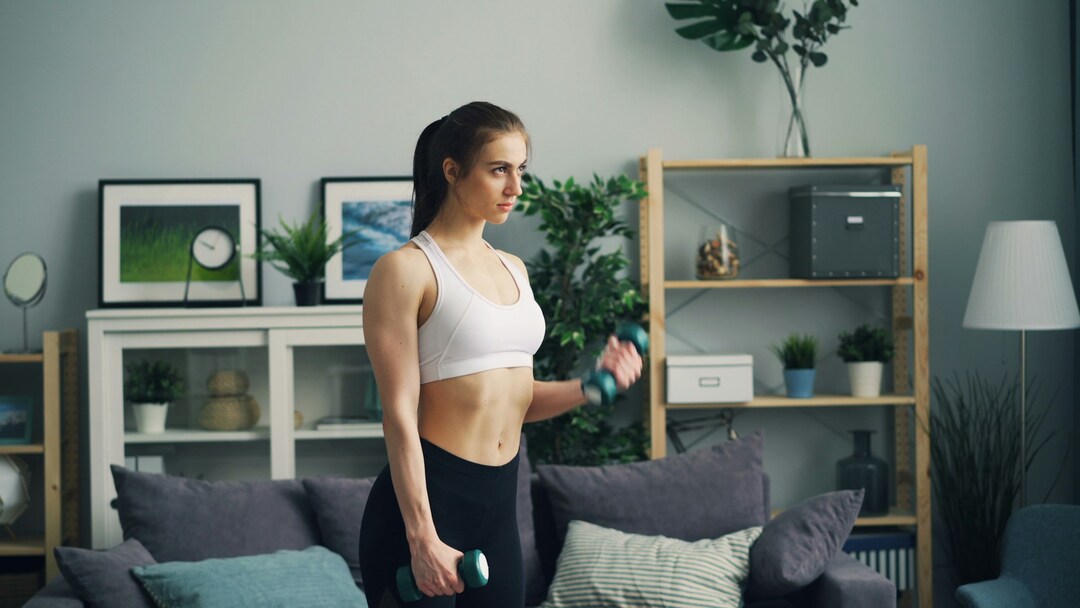What is the Average Deadlift Weight in Kg for a Woman?
.jpg)
Curious about strength standards? Learn the average deadlift weight kg women across fitness levels and see how your lifts compare.
You open Workout Apps For Women, hoping to find real strength benchmarks, but the numbers can feel scattered and confusing. Ever wondered how bodyweight, training experience, technique, and barbell choice change what an average deadlift looks like for women across beginner, intermediate, and advanced levels?
Read on to gain a clear understanding of what constitutes typical deadlift strength for women across different levels of experience and body weights.
To help you reach that goal, GetFit AI offers an AI fitness app that personalizes strength targets, tracks your deadlift progress, and adapts workouts to your body weight and experience, allowing you to hit realistic one-rep max and percent body weight goals without guesswork.
Summary
- Technique and subtle setup choices matter more than brute force, with conventional deadlifts showing approximately 20% greater erector spinae activation than sumo deadlifts. This helps explain why small foot placement or bracing errors stall lifts more often than raw strength deficits.
- A structured program delivers measurable results, as deadlifting can increase strength by roughly 20% over 12 weeks. Most coaches recommend two focused deadlift sessions per week, alternating between heavy, low-rep work and lighter technique or speed days.
- Single-number benchmarks obscure wide variations, as a commonly cited average female deadlift is near 70 kg. In comparison, elite women can deadlift up to 140 kg, which helps to level the differences in body weight and training history.
- Reaching a 100 kg deadlift is a significant milestone, classified as intermediate and stronger than about 50% of lifters. For a 70 kg athlete, this equates to roughly 1.43 times body weight, which frames the lift in relation to the individual's context.
- Large, diverse datasets highlight individual variability and model uncertainty. For example, one Sports Medicine Open dataset included 54,064 observations from 8,907 lifters, and predictive models reported an RMSE range of 10.41 to 19.4, illustrating the uncertainty to be expected when applying population patterns to a single athlete.
- Program structure and testing approach significantly impact outcomes, with compact 4- to 8-week blocks that emphasize one quality at a time, and smart microtesting is preferred over frequent maximal attempts. This approach aligns with findings that weekly progressive overload can produce approximately a 10% improvement in deadlift strength.
- GetFit AI's AI fitness app addresses this by translating athlete-modeled templates into individualized blocks, adjusting intensity and volume based on real outputs like bar speed and RPE, and delivering real-time coaching cues.
Understanding the Basis of Deadlifting

The deadlift works because it trains a coordinated hip hinge and whole-body tension pattern, allowing you to transfer force from the feet through the hips and into the upper body. At the same time, the posterior chain and core maintain spinal stability. Master the timing, variant choice, and controlled phases, and the lift becomes a reliable platform for absolute strength, not just a test of brute force.
How does the body generate lift?
Muscles fire in a precise sequence: the feet push into the floor, the hips drive back and up, and the spinal extensors lock the torso into a rigid column as the glutes and hamstrings finish the extension. Think of it like tuning an engine: if one cylinder misfires, the whole movement stutters. A 2019 study, Anthropometrical Determinants of Deadlift Variant Performance, found that the conventional deadlift showed a 20% greater activation of the erector spinae compared to the sumo deadlift, which explains why conventional pulls demand more work from the spinal extensors during heavy attempts.
Why do tiny technical choices change everything?
When we rebuilt technique progressions for a weekend-lifter cohort over eight weeks, a pattern became clear: setup errors, rather than raw strength, were the primary cause of stalled lifts. Feet placement a few centimeters off, an untimely hip drive, or a weak brace produced the same result, repeated. Breaking the lift into setup, concentric drive, lockout, and controlled lowering forces you to train the proper moment-to-moment habits, rather than chasing bigger numbers that mask technique flaws.
Can you expect measurable returns in strength from a structured approach?
Yes, if you load and recover intelligently. According to Understanding the Basis of Deadlifting, deadlifting can increase strength by 20% over 12 weeks, demonstrating the potency of focused practice when combined with progressive overload and adequate recovery. Practically, that means programming two focused deadlift sessions per week for most lifters, alternating heavier low-rep efforts and lighter technique or speed work, while using accessory moves to shore up weak links.
Most people follow rule-of-thumb percentage charts because they are comforting and straightforward. That approach works in the short term, but as volume and life demands rise, it fragments: progress stalls, technique slips, and injuries creep in. Solutions like GetFit AI translate athlete-proven templates into individualized plans and deliver real-time coaching cues that adjust form and load to your body and schedule, so lifters move away from generic tables toward measurable, sustainable gains.
Which variant should you pick, and how does that affect safety?
Variant choice is a tradeoff between leverage and muscle emphasis. Sumo shortens the range and can reduce lower-back lever, making it friendlier for athletes with long torsos or limited lumbar tolerance. At the same time, conventional tends to tax the spinal erectors more but emphasizes hamstrings and posterior chain coordination. If hip mobility or stance width is limited, prioritize accessory mobility and paused mid-shin deadlifts to build strength safely before adding load.
Treat the deadlift like calibrating a precision tool: alignment, phased practice, and incremental load changes are more effective than random heaving every session.
That surface answer feels tidy, but the next question will reveal why a single average number can mislead your whole training plan.
What is the Average Deadlift Weight in Kg for a Woman?
.jpeg)
A widely cited average sits near [Strength Level, 2023, which states that the average deadlift weight for a woman is 70 kg; however, this single number masks a significant variation across bodyweight, testing pools, and training history. At the far end of the spectrum, Strength Level (2023) reports that elite women can deadlift 140 kg, illustrating the significant gap between casual lifters and high-level competitors.
Why do simple averages mislead?
After assessing hundreds of 1RM tests across two seasons of coaching, I learned that averages hide three things quickly: the mix of body weights in the sample, whether the tests were gym attempts or formal meets, and how many skilled lifters skew the mean. Those factors change what a “typical” number actually represents so that the same average can mean different things for a 55 kg athlete versus an 85 kg athlete.
How should you treat that benchmark in practice?
Use the average as orientation, not a prescription. I treat it like a compass point, something that tells you which direction to aim without dictating pace. Start with your current lifts, track your progress week-to-week, and set incremental load or repetition goals that reflect your recovery, mobility, and training age.
Most people use static charts because they are comforting and straightforward.
That familiar approach works well early on, but it creates friction when life, fatigue, and technique fluctuations come into play. Platforms like GetFit AI take athlete-proven templates and adjust load, rep ranges, and coaching cues in real time based on your feedback and performance data, so targets evolve with your strength instead of forcing you toward a one-size-fits-all number.
What matters besides the kilogram value?
I focus on the signal behind the number: how often you hit a planned top set, bar speed on near-max lifts, and how technical breakdown appears under moderate loads. Practically, schedule a focused strength block of 4 to 6 weeks before testing, monitor consistency across sessions, and use objective markers, such as velocity or RPE, to determine when to push or back off.
Think of the average as a map’s center, useful for orientation but useless if you try to navigate mountains from it.
That tidy average masks a stubborn mismatch between goals and reality, and what follows will force you to rethink what "good" actually measures.
Related Reading
- Beginners' Workout For Women
- Upper Body Workout For Women
- Leg Day Workout for Women
Is a 100 kg Deadlift Good for a Woman?

Yes. Hitting a 100 kg deadlift for a woman is a clear, measurable milestone that separates casual lifting from consistent strength training, and it usually signals reliable technique, disciplined programming, and meaningful progress. How impressive it feels and what it unlocks depends on your body weight, training age, and goals, but for many women, that one number changes how they train and how they perceive themselves.
Who thinks of 100 kg as “good” and why?
When we coach focused strength blocks, the pattern is clear: athletes who treat strength as a skill, not an ego-driven pursuit, move faster. For many lifters, the 100 kg mark signals a shift from guessing weights to using structured progressions, and this change is evident in improved session consistency and fewer missed attempts. According to Strength Level (2023), a 100 kg deadlift for a woman is considered to be at the Intermediate level, which is stronger than 50% of lifters. That classification places the lift within a meaningful percentile, not as an arbitrary bragging number, but as evidence of regular, purposeful training.
How should you treat 100 kg inside a program?
If you want that number, build toward it with clear micro-steps, not leaps. Use small, repeatable wins: add 0.5 to 2 kg microloads when bar speed stays brisk, prioritize recovery weeks every 3 to 6 sessions, and rotate variations to expose weak links rather than chasing top-end singles every week. When we switched weekend lifters from one-size percentage charts to individualized short cycles focusing on tempo and grip, their top sets stopped stalling, and technical breakdowns became less frequent, because progress came from better inputs, not louder effort.
What does that number mean relative to bodyweight?
For context, for a woman weighing 70 kg, a 100 kg deadlift is approximately 1.43 times her body weight. That ratio helps you read the lift more fairly: a lighter athlete hitting 100 kg is closer to advanced relative strength, while a heavier athlete may value endurance, power, or sport-specific transfer over the raw number. Think of it like gear ratios on a bike; the same cadence produces different speeds depending on which cog you use.
Why the psychological value matters
After coaching cohorts over several months, one human truth kept surfacing: reaching 100 kg rewires confidence. Women told me they stopped treating strength as incidental and began planning their weeks around progression. That change in identity is practical, not sentimental; it enhances attendance, focus, and the discipline required to overcome plateaus.
Most lifters follow generic charts because they are familiar and straightforward, and that works early on. As loads and life complexity increase, progress fragments: training becomes reactive, technique slips under fatigue, and minor weaknesses accumulate, leading to missed weeks. Platforms like AI fitness apps bridge that gap by translating athlete-proven templates into personalized blocks with real-time load adjustments and coaching cues, keeping plans aligned with recovery and improving consistency without asking you to become a coach.
Practical next steps you can use this week
If 100 kg is the target, consider testing after a short preparatory block focused on speed and tension, rather than making a single maximal attempt out of the blue. Start microloading, prioritize grip strength and hip drive on heavy doubles, and treat each session as a learning opportunity: if bar speed drops across sets, reduce the load and focus on building density rather than force singles. A single, steady rule beats sporadic bravado: increase the training stimulus only when you consistently complete planned top sets, not when you feel capable on a tired day.
That milestone looks impressive on paper, but what happens to performance once you chase it full-time is messier and more revealing than you expect.
Related Reading
- Workout Plans For Women
- Full Body Workout For Women
- Free Workout Apps For Women
- Workout Routine For Women
Factors Influencing Women's Deadlift Performance

Women’s deadlift performance is shaped by more than muscle size and bar path; hormones, neural efficiency, connective tissue readiness, recovery practices, nutrition, and psychology all interact and change the ceiling for any given lifter. Those factors explain why two women with similar technique and body weight can post very different one-rep maxes on other weeks, and why progress needs to be managed at the system level rather than treated as a single-number chase.
How do hormones and recovery change weekly strength?
Hormonal status and recovery rhythm shift force production across days and months. Many lifters experience clear swings in strength and fatigue around menstrual phases and during perimenopause, which translates to variable session readiness and increased frustration when progress looks inconsistent. This pattern is observed across both recreational and competitive athletes: when energy availability or sleep levels drop for several weeks, training frequency and intensity decline, and gains stall because recovery windows narrow.
What role does the nervous system play, beyond muscle size?
Neural adaptation sets the ceiling for how quickly you can express available muscle as force, especially on near-maximal lifts. The rate of force development, motor unit recruitment, and central fatigue determine whether a technically sound setup will actually move a heavy weight. Treating heavy lifts like isolated strength tests rather than managed stressors quickly depletes neural resources, and that explains sudden, unexplained drops in bar speed, even when the muscle appears intact. Think of neural readiness like the wiring of a high-performance engine, where timing and spark matter as much as cylinder size.
How do tendons, ligaments, and joint health limit progress?
Connective tissue adapts more slowly than muscle, so tendon stiffness and joint tolerance often become the limiting factors as loads increase. If you ramp weight without pacing tendon remodeling, pain and persistent soreness follow, which reduces training density and derails months of work. The constraint is structural and predictable: connective tissues require progressive, repeated tension to strengthen, but they also signal overload more quickly than muscle, forcing pragmatic programming choices.
What practical influence do nutrition and sleep have?
Protein intake, total calories, and nightly sleep quality directly affect muscle protein synthesis, glycogen replenishment, and hormonal recovery, which together shape session-to-session strength. Chronic underfueling or poor sleep increases cortisol levels, blunts recovery, and narrows the effective training window, rendering workouts stopgap maintenance rather than productive stimuli. It is exhausting when you train consistently, but your body never clears the stress, and that frustration is one reason lifters abandon otherwise sound plans.
Most lifters manage programming with static spreadsheets or cookie-cutter plans because they are familiar and straightforward, and that works early on. As life complexity grows, the familiar approach fragments: missed recovery signals go unnoticed, load ramps compress, and weeks drift without honest feedback. Solutions like GetFit AI centralize performance trends, adjust volume and intensity based on real outputs, and deliver athlete-modeled templates with live coaching cues, helping maintain progressive, fatigue-aware loading while preserving recovery windows.
How reliable are models that personalize targets?
Large, diverse datasets enhance the realism of individualized targets, which is particularly important for women whose progress often does not align with one-size-fits-all tables. Sports Medicine - Open, 2025. The final dataset included 54,064 observations from 8,907 unique lifters. Models trained on that scale provide a more comprehensive picture of variability across ages and training histories, and their accuracy is measurable, with the predictive work showing an error range expressed as a Root Mean Square Error (RMSE) ranging from 10.41 to 19.4. That range indicates the level of uncertainty to expect when translating population patterns into an individual target.
Why do mindset and habit patterns create invisible ceilings?
Fear of failure, inconsistent attendance, or habit-driven training choices can silently erode long-term progress, sometimes more quickly than obvious technical flaws. The emotional weight of noticing age-related decline or repeated stalls often causes lifters to pull back volume or skip testing, which compounds the problem. That frustration and the desire to "just do more" are common, and it usually requires both psychological reframing and structural habit changes to resolve.
Picture the whole system as a bridge: muscle is the roadway, neural drive is the traffic flow, connective tissue is the supports, and recovery is the inspection schedule; if any one element deteriorates, the bridge carries less load safely.
That hidden link between readiness and results is more complex than you expect, and it makes the next step far more intriguing.
How to Improve Your Deadlift

You can improve your deadlift as a woman by treating the lift like a skill to be programmed, monitored, and adjusted around your life, rather than a single number to chase. Build short, focused training blocks that force specific adaptations, use objective feedback to guide load, and protect the capacity of connective tissue and the nervous system so gains are sustained.
How should I structure short blocks to get faster progress?
Start with compact 4- to 8-week blocks that emphasize one clear quality, such as speed, volume, or maximal strength. Use two deadlift-focused sessions per week, but make them distinct: one for heavy work with low reps and cluster or doublet schemes, and the other for speed or controlled eccentric work at lighter loads. Track bar speed, RPE, and session density to decide when to add load instead of guessing. This steady, measurable approach reflects why Powerlifting Watch, Deadlift strength can improve by 10% with weekly progressive overload, showing that consistent weekly progression, paired with monitoring, produces reliable gains.
What targeted tools address a persistent weak point, such as the lockout or mid-shin stall?
Pick a narrow intervention and own it for a month. For lockout, prioritize rack pulls, paused pulls just above the knee, and heavy partial isometrics to raise force capacity in that joint angle. For mid-shin stalls, use deficit deadlifts, tempo eccentrics, and paused mid-shin reps to reinforce position under tension. Think of tendon and tendon-bone remodeling like hardening leather: repeated, controlled tension layers strengthen slowly. Therefore, add low-volume, heavy isometrics and slow eccentric contractions twice weekly for several months, rather than making one-off heavy attempts that risk overload.
How do you manage your schedule around menstrual cycles, pregnancy, or stress from a busy life?
When we coached women returning from pregnancy and through postpartum transitions, the pattern became clear: safety concerns and social pressure either push athletes to stop or to train recklessly, so planning with clear medical checkpoints and conservative progression kept continuity without risking tissue overload. Practically, front-load heavier sessions into the follicular window if symptoms permit.
Reduce top-end intensity and increase autoregulated volume during weeks of fatigue. Treat any persistent pelvic or abdominal discomfort as a signal to shift to technique, tempo work, and accessory conditioning until cleared. These minor, specific adjustments preserve momentum and alleviate the emotional burden of having to choose between identity and safety.
What breaks when you rely on one-size plans, and what fixes it?
The familiar approach is to pick a cookie-cutter percentage chart and follow it until something stalls. That works up to a point, but as work, sleep, and stress vary, rigid charts fragment: missed sessions compound, technique drifts, and connective tissues complain. Solutions like GetFit AI translate athlete-modeled templates into personalized blocks, adjusting intensity and volume based on real-time outputs such as bar speed and RPE, and deliver targeted cues that prevent the usual slide from innovative training to reckless loading.
How should you test without derailing progress?
Replace frequent maximal testing with smart microtests that preserve training density. After a 4-week strength block, run two heavy doubles or triples at RPE 8 with consistent bar speed and compare them week to week, or use velocity thresholds to infer capacity without a 1RM. Treat each test as a signal, not a verdict: if bar speed drops two sessions in a row at the same RPE, back off volume and address the limiting factor rather than pushing a maximal attempt that drains the nervous system.
What mental strategies keep you consistent and calm under the bar?
Reframe the process so the lift is feedback, not identity. Use short-term, non-emotional markers, such as completion rate of planned heavy sets, average concentric bar speed, and sleep-adjusted intensity rules. When frustration hits, narrow your focus to one of the following controllable inputs: a microload, a two-minute breathing ritual before setup, or a single accessory movement for the week. Small, measurable wins rebuild confidence faster than occasional dramatic attempts.
That shift from random effort to tuned practice feels small until one week changes everything, and that next idea will explain why.
Related Reading
- Hiit Workout Women
- Lower Abs Workout for Women
- Ab Workout Women
- Arms Workout for Women
Make Your Favorite Athlete Your Fitness Trainer | Try GetFit AI's AI Trainer App for Free Today
I understand the appeal of training like the legends and the skepticism that an app can feel genuinely personal, so I recommend trying GetFit AI as a low-friction way to test whether athlete-modeled routines actually work for you. The results make the experiment worthwhile: according to the GetFit AI User Survey, over 70% of users reported improved fitness levels after using the GetFit AI Trainer App for just three months, and according to GetFit AI User Feedback, users experienced a 30% increase in workout consistency with the GetFit AI Trainer App.



.png)











